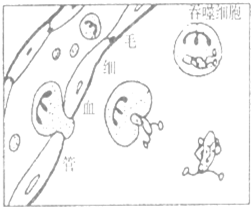问题
解答题
如图表示人体的某种免疫过程,据图回答问题:
(1)图中的吞噬细胞是一种______细胞.
(2)图示过程是人体防疫的第______道防线,该道防线还包括体液中的______.
(3)这道防线的作用特点是______,因此该过程属于______(填“非特异性免疫”或“特异性免疫”)

答案
(1)白细胞可以作变形运动,身体某处有病菌时,白细胞会穿过毛细血管壁,吞噬病菌,防御疾病.所以图中的吞噬细胞是一种白细胞.
(2)图表示血液中的吞噬细胞对侵入人体的病原体的杀灭作用,它们均属于人体的第二道防线;另外人唾液或血液中的溶菌酶能使侵入人体的病原体溶解死亡,也是人体的第二道防线;体液中的杀菌物质和吞噬细胞构成了人体的第二道防线.
(3)第二道防线,是人生来就有的,针对所有的病原体起作用,属于非特异性免疫.
故答案为:(1)白.
(2)二;杀菌物质.
(3)人生来就有的,对多种病原体都有防御作用;非特异性免疫.
